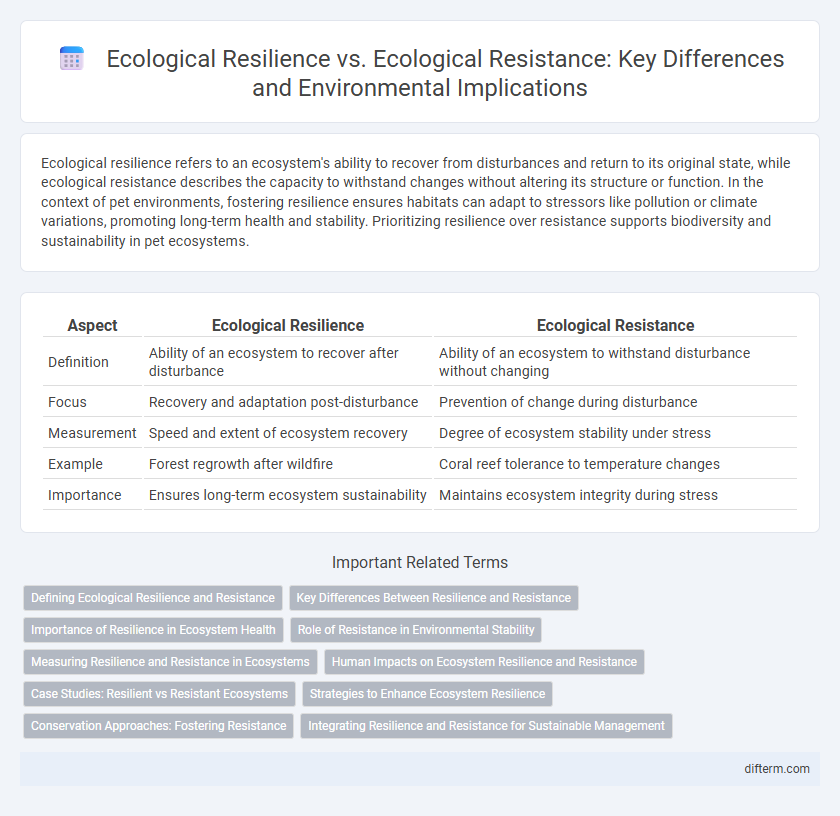Ecological resilience refers to an ecosystem's ability to recover from disturbances and return to its original state, while ecological resistance describes the capacity to withstand changes without altering its structure or function. In the context of pet environments, fostering resilience ensures habitats can adapt to stressors like pollution or climate variations, promoting long-term health and stability. Prioritizing resilience over resistance supports biodiversity and sustainability in pet ecosystems.
Table of Comparison
| Aspect | Ecological Resilience | Ecological Resistance |
|---|---|---|
| Definition | Ability of an ecosystem to recover after disturbance | Ability of an ecosystem to withstand disturbance without changing |
| Focus | Recovery and adaptation post-disturbance | Prevention of change during disturbance |
| Measurement | Speed and extent of ecosystem recovery | Degree of ecosystem stability under stress |
| Example | Forest regrowth after wildfire | Coral reef tolerance to temperature changes |
| Importance | Ensures long-term ecosystem sustainability | Maintains ecosystem integrity during stress |
Defining Ecological Resilience and Resistance
Ecological resilience is the capacity of an ecosystem to absorb disturbances and reorganize while undergoing change, maintaining its essential functions and structure. Ecological resistance, in contrast, refers to an ecosystem's ability to remain unchanged when exposed to external stressors or disturbances. Understanding these concepts is vital for managing natural environments and developing strategies to mitigate the impacts of climate change and human activities.
Key Differences Between Resilience and Resistance
Ecological resilience refers to an ecosystem's ability to absorb disturbances and reorganize while undergoing change, maintaining its essential functions, structures, and feedbacks. Ecological resistance describes an ecosystem's capacity to remain unchanged when subjected to environmental stress or disturbances. Key differences include resilience emphasizing recovery and adaptation after impact, whereas resistance focuses on the prevention of change during impact, with resilience promoting long-term sustainability and resistance ensuring immediate stability.
Importance of Resilience in Ecosystem Health
Ecological resilience, the ability of ecosystems to recover from disturbances, is crucial for maintaining long-term ecosystem health and function. It enables habitats to adapt to environmental changes, preserving biodiversity and ecosystem services. Unlike ecological resistance, which slows change, resilience ensures ecosystems can bounce back and sustain ecological balance after stress events.
Role of Resistance in Environmental Stability
Ecological resistance plays a critical role in environmental stability by enabling ecosystems to withstand disturbances without significant changes in structure or function. High resistance in habitats, such as mature forests or coral reefs, reduces vulnerability to stresses like pollution, climate fluctuations, or invasive species. This inherent capacity helps maintain biodiversity and ecosystem services, contributing to long-term sustainability and resilience.
Measuring Resilience and Resistance in Ecosystems
Measuring ecological resilience involves assessing an ecosystem's capacity to recover and return to its original state after disturbances, often quantified through metrics like recovery time and species diversity restoration rates. Ecological resistance is evaluated by the extent to which an ecosystem can withstand external stress without significant changes in structure or function, commonly measured through indicators such as stability in biomass or nutrient cycling during disturbances. Both resilience and resistance metrics rely on long-term monitoring data and advanced modeling tools to accurately capture ecosystem responses to environmental stressors.
Human Impacts on Ecosystem Resilience and Resistance
Human activities such as deforestation, pollution, and urbanization significantly decrease ecological resistance by making ecosystems more vulnerable to disturbances. However, ecosystems with higher biodiversity and functional redundancy demonstrate greater ecological resilience, enabling quicker recovery from human-induced stresses. Restoration efforts that enhance habitat connectivity and reduce pollutants can improve both resilience and resistance, supporting long-term ecosystem stability.
Case Studies: Resilient vs Resistant Ecosystems
Resilient ecosystems, such as the Yellowstone National Park, recover quickly from disturbances like wildfires, restoring biodiversity and ecological functions over time. In contrast, resistant ecosystems, exemplified by certain tropical rainforests, maintain stability by withstanding environmental stress without significant changes in structure or species composition. Case studies reveal that resilience supports long-term adaptability, while resistance emphasizes immediate protection against external pressures.
Strategies to Enhance Ecosystem Resilience
Ecosystem resilience strategies prioritize biodiversity conservation, habitat restoration, and adaptive management to enable recovery from environmental disturbances, contrasting with ecological resistance that emphasizes maintaining stability against change. Implementing ecological corridors and promoting species diversity increase ecosystem adaptability, enhancing resilience to climate change and anthropogenic stressors. Integrating traditional ecological knowledge with modern conservation practices further strengthens ecosystem capacity to absorb shocks and sustain functionality over time.
Conservation Approaches: Fostering Resistance
Ecological resistance refers to an ecosystem's ability to withstand disturbances without significant change, making it a critical focus in conservation strategies aimed at preserving habitat stability. Conservation approaches that foster resistance prioritize maintaining native species diversity, restoring natural processes, and minimizing external stressors such as pollution and invasive species. These methods enhance ecosystem robustness, ensuring long-term functionality despite environmental pressures.
Integrating Resilience and Resistance for Sustainable Management
Ecological resilience refers to an ecosystem's capacity to recover from disturbances, while ecological resistance denotes its ability to withstand environmental stress without significant change. Integrating resilience and resistance in sustainable management enhances ecosystem stability by promoting adaptive strategies that maintain biodiversity and ecosystem functions. This combined approach supports long-term conservation goals amid climate change and anthropogenic pressures.
ecological resilience vs ecological resistance Infographic

 difterm.com
difterm.com